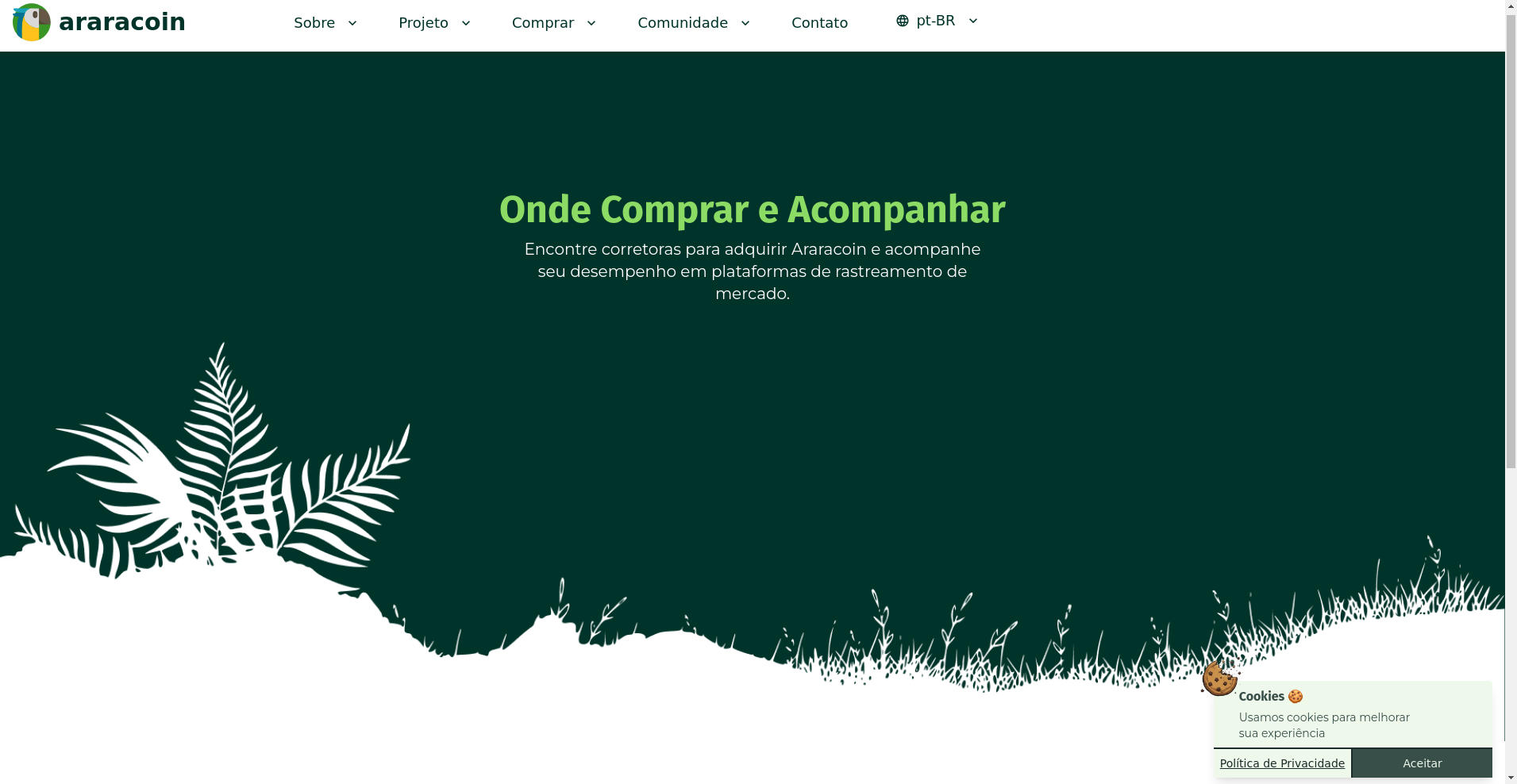Araracoin ($ARARA) Review: A Data-Driven Legitimacy and Risk Assessment

What Is Araracoin: An Introduction
Araracoin (ticker symbol $ARARA) is a blockchain-based project centered around the preservation of endangered species through a charitable and community-driven ecosystem. It integrates innovative technology, including smart contracts on the Binance Smart Chain (BSC), and aims to create a transparent and participatory model for wildlife conservation. The project combines environmental impact with the potential for token utility within a Web3 ecosystem, leveraging blockchain's transparency to foster trust among contributors and conservation organizations.
This review provides an impartial analysis of Araracoin's strengths and weaknesses, focusing on its technical infrastructure, team credibility, tokenomics, security, and long-term sustainability. In the landscape of crypto projects claiming societal impact, especially environmental, it is crucial to evaluate whether such claims are supported by robust fundamentals or if risks undermine their legitimacy. For a deeper understanding of how to approach such projects, consider learning about due diligence for environmental crypto projects.
The Team and Vision Behind Araracoin
The project is spearheaded by Luciano Bernal, whose background predates blockchain, rooted in the development of management systems since the late 1990s. Bernal's extensive experience in software development, including mobile apps and business intelligence, lends some credibility. He is supported by two key team members: João Luiz, responsible for smart contract development, and Thais Vilarinho, front-end developer and systems analyst. Additionally, the project benefits from the support of Bernal Software Ltda., a company with over two decades in technological solutions, and a dedicated marketing team.
While the team’s professional history appears transparent and rooted in software engineering, there is little public evidence of prior blockchain or conservation-specific expertise. The lack of high-profile advisors, notable partnerships, or clear industry veteran involvement tempers confidence in their capacity to deliver, especially on a complex environmental mission that demands operational robustness and strategic partnerships.
- Roadmap milestones include smart contract creation, project qualification systems, community voting, and foundation establishment.
- The team emphasizes transparency via audits, community engagement, and planned decentralized governance.
- Perceived ability to execute depends on their capacity to meet these milestones on schedule, which remains unverified outside of their internal planning documents.
Thus, while the team’s technical expertise appears solid in software development, their experience in blockchain governance and environmental project management remains less transparent, raising questions about their execution capability.
Araracoin Security Audit Results
According to the Cyberscope audit report, Araracoin underwent a formal smart contract review, which is a positive sign for technical legitimacy. The audit, conducted as of October 2024, assessed the token's smart contract deployed on BSC, focusing on potential vulnerabilities, control points, and compliance with best practices. Understanding how to interpret these reports is key; explore how to analyze Cyberscope audit reports for crypto projects.
Key findings include:
- High Criticality Issues: The audit identified significant concerns, including potential reentrancy vulnerabilities, incomplete access control, and the presence of functions that could be exploited if mismanaged.
- Score and Compliance: The project received a security score of 89/100, which, while respectable, indicates room for improvement to meet best security standards for token contracts.
- Control Centralization: Certain functions are owner-dependent, especially around tax management and trading permissions, creating a potential "single point of failure" risk. Projects on BSC should adhere to Binance Smart Chain security best practices to mitigate such issues.
- Vesting and Lock-up Contracts: Include mechanisms to prevent immediate dumping, but details on their implementation and audit of fund allocation are scant.
This audit, though a positive step, highlights potential vulnerabilities typical of many early-stage tokens. The identified issues, particularly around access controls, could be exploited if the project's governance is not carefully managed or if private keys are compromised. For investors, it underscores the importance of monitoring ongoing security updates and audit recertifications.
In sum, the security posture is cautiously acceptable but warrants ongoing vigilance, especially given the critical role smart contracts play in fund management and governance.
Analyzing the Araracoin ($ARARA) Token: Supply, Distribution, and Utility
ARARA's tokenomics demonstrate a thoughtfully structured distribution designed to foster long-term sustainability. The total supply is capped at 100 billion tokens, with a gradual release schedule aligned with project milestones and community involvement.
- Total Supply: 100 billion ARARA tokens — a notably large supply that can raise concerns regarding inflation and token value stability. Understanding the impact of such supply is crucial, and exploring token inflation and deflation mechanisms can provide valuable context.
- Initial Allocation Breakdown:
- Pre-Sale: 10% (10B), with progressive pricing from $0.000100 to $0.000150
- Launch: 20% (20B), locked until exchange listing
- Third-Party Services (marketing, audits): 5% (5B)
- Investors (private sale phased over 2 years): 25% (25B)
- Team and Founders: 20% (20B), vested over 4 years
- Conservation Projects: 20% (20B), semi-annual releases over 4 years
- Vesting and Lock-up: Most tokens are subject to vesting (team, investors) and lock-up periods, designed to prevent immediate dumps and stabilize the token price.
- Utility: Primarily governance and funding for conservation projects, with plans for future ecosystem expansion via API validation and community voting.
The absence of detailed utility functions beyond governance and donation management raises questions about the token's inflationary risks. While vesting is intended to prevent dumping, the large total supply and phased releases could lead to dilution if demand does not materialize as projected.
Finally, the fact that all tokens are projected to be in circulation by 2028 indicates a highly inflationary scenario, which could undermine long-term value appreciation. This makes the token's economic model potentially vulnerable to market volatility and demand fluctuations.
Assessing Araracoin's Development and Ecosystem Activity
The project’s development roadmap is ambitious, outlining phases from smart contract deployment, community governance systems, partnership formations, to establishing a foundation. Critical milestones include the launch of voting systems, project submission portals, and smart contract-based donation fee distributions.
So far, the project has achieved some foundational technical milestones, such as deploying the ERC20 token, vesting contracts, and initial audits. The existence of detailed milestones and a clear timeline is promising; however, there is limited evidence of active ecosystem engagement, real-world partnerships, or adoption metrics beyond the technical steps.
Community engagement remains modest, with approximately 900 members in the Telegram group and social media following under 2,000, indicating limited market traction at this stage. The absence of third-party endorsements or prominent conservation partnerships weakens the perception of credibility, although the project’s messaging aligns with promising environmental goals.
Ongoing development updates, new exchange listings, and active project participation are needed to validate long-term viability. Currently, much of the activity appears centered around roadmap milestones rather than demonstrable ecosystem traction.
The Fine Print: Analyzing the Terms and Conditions
The project’s publicly available legal documents, including Terms of Use and Privacy Policy, appear standard and transparent. No overtly risky clauses—such as restrictions on user rights, unreasonable liability limitations, or unclear jurisdiction—are visible from the provided summaries. The ownership controls on smart contracts, including functions related to tax, trading permissions, and vesting, are owner-controlled but include provisions for multi-signature or DAO transfer to decentralize management.
However, the reliance on owner-controlled functions for critical controls (e.g., tax rates, trading permissions) inherently introduces centralization risks that could be exploited if private keys or governance transitions are compromised. The project recommends transfer of ownership to DAOs or multisig wallets—an essential step for true decentralization and legitimacy. This aligns with the general principles of securing your BSC project.
Otherwise, the legal framework emphasizes consumer protection, with clear contact points and adherence to standard policies, which lends some legitimacy but does not eliminate regulatory risks—especially since environmental impact projects may face scrutiny in different jurisdictions.
Final Analysis: The Investment Case for Araracoin
In sum, Araracoin presents a compelling narrative integrating blockchain with environmental activism, supported by a technically sound, audit-reviewed smart contract foundation. The transparent tokenomics, phased vesting, and governance plans indicate thoughtful planning. However, several risks temper its long-term investment attractiveness:
- Technical Risks: The audit identified vulnerabilities that, if exploited, could undermine user trust or funds safety.
- Credibility and Experience: The team, while experienced in traditional software, lacks prominence in blockchain governance or conservation-specific projects, raising concerns about execution capabilities. Projects should also consider due diligence on their team to ensure they have the necessary expertise.
- Economic Risks: Large supply, phased release, and inflation risk dilute potential token value, especially without high demand or active ecosystem development.
- Community Engagement: Current levels of user participation and partnership are modest, indicating early-stage adoption.
- Decentralization and Control: Owner-controlled functions pose centralization risks, which need to be addressed before long-term trust can be established.
Prospective investors should weigh these points carefully. While the project aligns with noble environmental goals and demonstrates technological due diligence, its ability to deliver on promises and sustain long-term growth remains uncertain. As with any nascent project, ongoing vigilance, security updates, and ecosystem expansion will determine its ultimate legitimacy and reward potential.
By understanding these core factors, investors can make more informed decisions rooted in sound analysis rather than hype or unverified claims.

Amanda Harris
Technical Security Educator
Security professional passionate about the "human firewall." I translate complex crypto threats into simple, actionable security habits for everyday users.
Similar Projects
-
Lossless
Lossless ($LSS) Review: A Deep Dive into Its Tech & Risks
-
CryptoGame
Crypto Project Review & Scam Checker: Is CryptoGame a Legit Investment or Scam?
-
DEBT RELIEF AI
DEBT RELIEF AI Review - Crypto Project Scam Checker
-
Book of Mew (BOMEW)
In-Depth Review of Book of Mew (BOMEW): Crypto Scam Checker and Project Scam Review
-
Golem
Golem Review: Scam or Legit Crypto? In-Depth Legitimacy Check